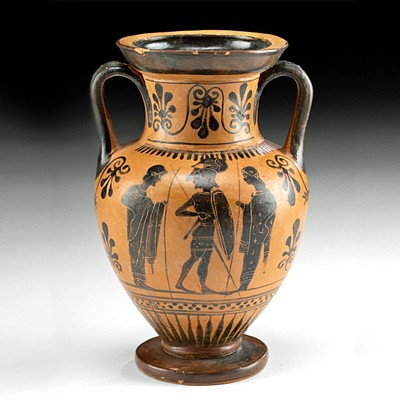Egyptian Limestone Relief Sculptor's Model of Pharaoh
About Seller
686 S Taylor Ave, Ste 106
Louisville, CO 80027
United States
Selling antiquities, ancient and ethnographic art online since 1993, Artemis Gallery specializes in Classical Antiquities (Egyptian, Greek, Roman, Near Eastern), Asian, Pre-Columbian, African / Tribal / Oceanographic art. Our extensive inventory includes pottery, stone, metal, wood, glass and textil...Read more
Two ways to bid:
- Leave a max absentee bid and the platform will bid on your behalf up to your maximum bid during the live auction.
- Bid live during the auction and your bids will be submitted real-time to the auctioneer.
Bid Increments
| Price | Bid Increment |
|---|---|
| $0 | $25 |
| $300 | $50 |
| $1,000 | $100 |
| $2,000 | $250 |
| $5,000 | $500 |
| $10,000 | $1,000 |
| $20,000 | $2,500 |
| $50,000 | $5,000 |
| $100,000 | $10,000 |
| $200,000 | $20,000 |
About Auction
Mar 9, 2023
Artemis Fine Arts info@artemisgallery.com
- Lot Description
**First Time At Auction**
Egypt, Ptolemaic period, ca. 4th to 1st century BCE. A rare and quite impressive limestone sculptor's model relief depicting the upper body of a bare-chested pharaoh wearing the khepresh, also known as a the blue or war crown, with an uraeus. Shown in the traditional profile view for which the Egyptians are so well known, the ancient royal faces right, presenting a regal visage with an elongated eye, a slender nose, and a prominent ear jutting out from beneath his crown. His arms extend downwards from his broad shoulders, lying to either side of his slender, tapering torso. Models like this were created by a master artisan for their assistants to follow while they were decorating a wall and also to serve as the study piece of an apprentice. In some cases, they also were used as donations. Pharaohs are often depicted wearing the khepresh, shown here, during battle or in ceremonies. Size: 5.25" H (13.3 cm) on included custom stand.
Though sculptors' models are typically difficult to date – with some being from the Amarna period of the 18th Dynasty when new forms of statuary came in – most known examples are from the Late Dynastic and Ptolemaic periods. The Egyptians were keen observers of fauna, with many different animals gracing their mythology, artwork, and hieroglyphics; however, anthropomorphic models were typically among the most challenging to carve accurately.
While sculptors' models appear to be from larger composite figures, their incomplete presentation could be an entirely separate item typology. Ancient Greek sculptural incompleteness was a generic form of presentation as the viewer could extrapolate who or what a sculpture was meant to represent. In contrast, the ancient Egyptians would view an incomplete votive work of art only as it was: part of a bird, a disembodied head, or in one instance the hind quarters of a lion. According to Eric Young of the Metropolitan Museum of Art, "When we consider the Egyptian pieces as sculptors' models, however, their incompleteness is no longer disturbing, but entirely understandable. As is the case with unquestioned sculptors' models…the apprentice sculptor concentrated his energies on those portions of the figure that he found intriguing, or most difficult, and the master sculptor demonstrated the correct way to delineate a head…" ("Sculptors' Models or Votives? In Defense of a Scholarly Tradition." The Metropolitan Museum of Art Bulletin, March 1964, p. 255).
Cf. Walters Art Museum, 22.390.
Please note that this piece is a dropship item, meaning that it will be shipping from the consignor’s location. All information regarding condition, size, stone identification, and metal content have been provided by the consignor.
Provenance: private New York, New York, USA collection; ex-private Berkeley, California, USA collection, acquired in the 1990s
All items legal to buy/sell under U.S. Statute covering cultural patrimony Code 2600, CHAPTER 14, and are guaranteed to be as described or your money back.
A Certificate of Authenticity will accompany all winning bids.
We ship worldwide and handle all shipping in-house for your convenience.
#177282Condition
Good for what remains. Paint remaining on surface and fragmented borders.
- Shipping Info
-
All shipping is handled in-house for your convenience. Your invoice from Artemis Gallery will include shipping calculation instructions. If in doubt, please inquire BEFORE bidding for estimated shipping costs for individual items.
-
- Buyer's Premium



 EUR
EUR CAD
CAD AUD
AUD GBP
GBP MXN
MXN HKD
HKD CNY
CNY MYR
MYR SEK
SEK SGD
SGD CHF
CHF THB
THB















